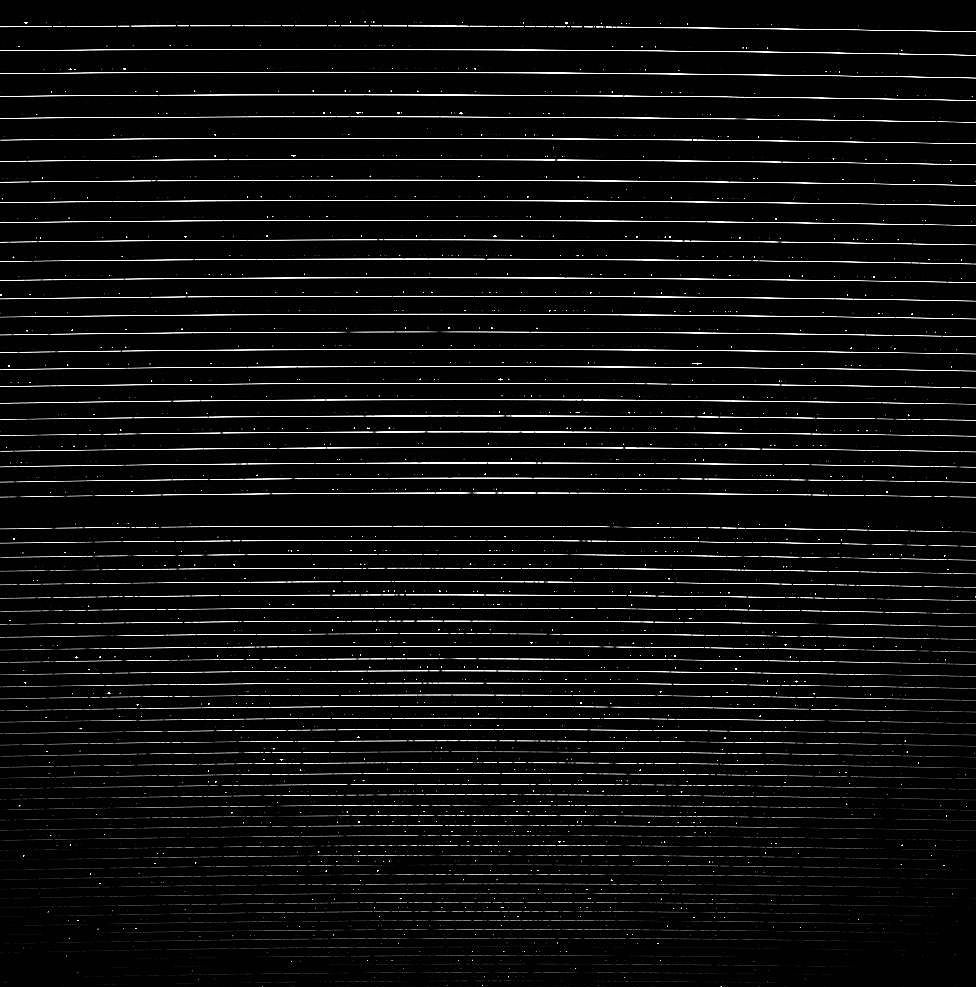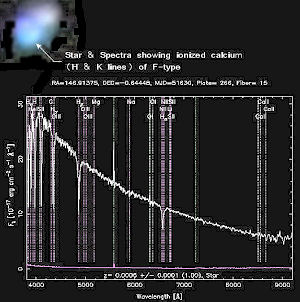Stars &
Their Spectral Light
| Stars & Spectra | Binary | Protostar | Brown Dwarf | White Dwarf | Red Giant | Cepheid | Neutron Star | Supergiants | Quasar |





Actual Spectra
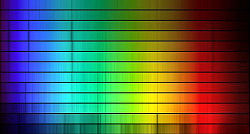
Stellar Spectral Types: OBAFGKM Image Credit: APOD
Below you'll find images from research centers and observatories across the internet showing examples of actual spectral data obtained from stars and various stellar objects. A number of these sites offer interactive education on the subject which are designed to enhance online learning opportunities. These sites interact with the user usually through either a text-based or graphical user interface.
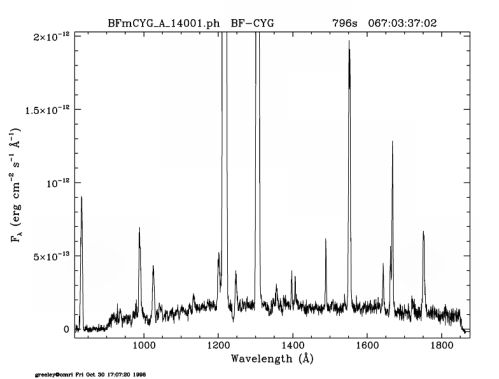
Above is a graph of the spectral data of Star TYC 2136-175-1 obtained by the Astro-2 HUT survey. Shown below is an image obtained from the Aladin desktop applet of the star in color (RGB).

Here is another spectra image from the NOAO website with the spectrum narrowed in the blue wavelength: "The absorption lines of the elements hydrogen, barium, neodymium and strontium are labelled on this section of the spectrum of star HD126587".
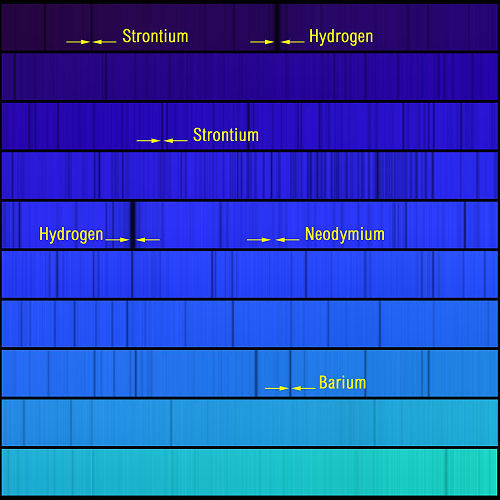
Below is another image of HD126587 from the Aladin Sky Atlas which lists this star as having a Gw spectral type.
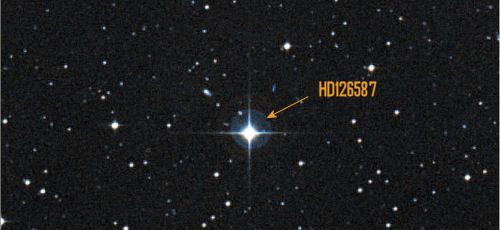
Here is an image of the Spectra of Wolf 1346 in another graph format (credit NOAO/AURA/NS). The 3 lines in this graph are a comparsion study to show the effectiveness of the new red-sensitive spectrograph that was installed on the Mayall 4-meter telescope (an eighteen story tall observatory located just below the summit of Kitt Peak) in 2001

This particular star is a spectral type D which is a modern classification scheme used for white dwarfs. The designation DA is a further division of the class into spectral types and designates the visible composition of a white dwarf's outer layers; DA in this case denotes a hydrogen-rich atmosphere. See Wikipedia - Stellar classification
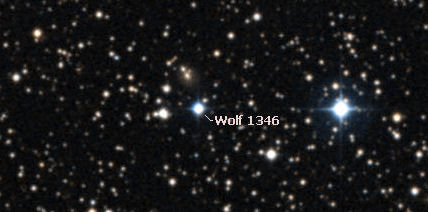
Our next image is interesting in that it shows the spectrum of star HD100623 in "raw" format. This image is from the ESO website: "A HARPS untreated ("raw") exposure of the star HD100623, of the comparatively cool stellar spectral type K0V. The frame shows the complete image as recorded with the 4000 x 4000 pixel CCD detector in the focal plane of the spectrograph. The horizontal white lines correspond to the stellar spectrum..." Click on image to open a larger version in new window.
Below is an image from the ESO website of HD47536, a spectral type K0III star.

This particular star is very interesting in that it has been a recent addition (2003 & 2007) in the Extrasolar Planets Encyclopaedia. The term Extrasolar Planet refers to a planet beyond the Solar System that is orbiting around another star. Extrasolar planets are one of the more recent astronomical studies (1990 onwards) that have begun to pick up serious momentum and are possible canidates regarding the search for life on other worlds. See the The Extrasolar Planets Encyclopaedia for the catalog of extrsolar planets discovered todate.
Sun, Galaxy, Molecular Cloud
the spectra of other stellar objects
Stars are not the only stellar object for which spectral research and data is collected and analysed. Nor are the survey missions confined to just the visible light spectrum but cover the full range of light, such as ultraviolet and infrared. Below are examples of other stellar objects and their spectra.
Below is the spectrum of our Sun. This image was created from a digital atlas observed with the Fourier Transform Spectrometer at the McMath-Pierce Solar Facility at Kitt Peak National Observatory. The dark absorption lines are very apparent in this image. Credit N.A.Sharp, NOAO/NSO/Kitt Peak FTS/AURA/NSF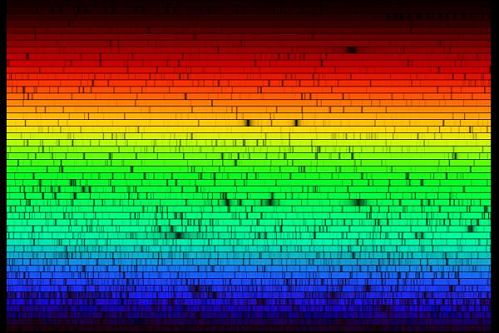
Seen below: "Average spectra of VVDS galaxies in three redshift, i.e. distances or ages, ranges (top to bottom): 1.4 to 2.5, 2.5 to 3.5, and 3.5 to 5.0. The main spectral features expected at these wavelengths are clearly visible in all spectra." From the VIMOS VLT Deep Survey. Source credit: ESO Website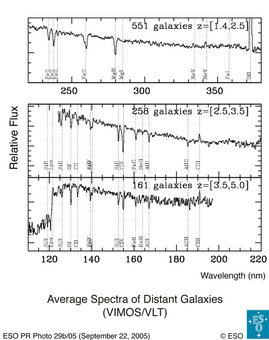
The giant molecular cloud G327.3-0.6, a star forming region, is surveyed by the Atacama Pathfinder Experiment or APEX. "More than 5000 spectra were taken in the J=3-2 line of the carbon monoxide molecule (CO), one of the best tracers of molecular clouds, in which star formation takes place." Source credit: ESO website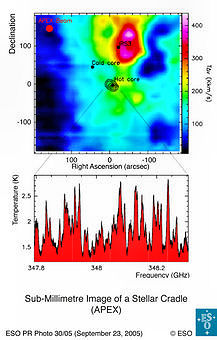
Supernova are another stellar object in which spectral data is gathered. The below image shows four spectra of SN2006X tracing the evolution of the Sodium line as a function of time. Source credit: ESO website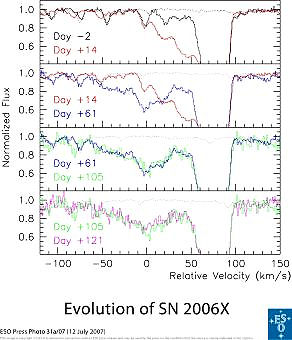
SN2006X is located (RA 12 22 53.88 Dec +15 48 31.9) 12" W and 48" S of the center of the apparent host galaxy NGC 4321 which are shown in this image. To view addiontal images (before & after) of the galaxy and supernova Click Here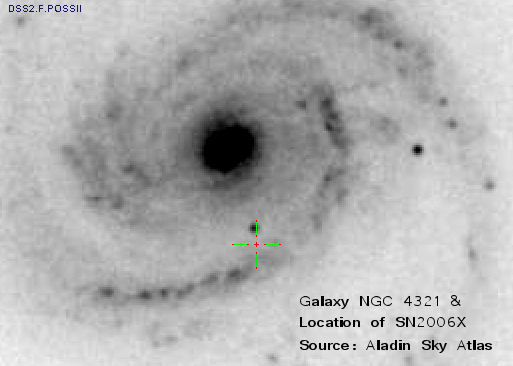
See Supernova at Wikipedia for more information on Type 1a supernova.
Additional study
See Wikipedia as a starting point for further reading regarding extrasolar planets.
See European Southern Observatory (ESO) (2005, September 26). Desert Pathfinder At Work: Sub-millimetre APEX Telescope Inaugurated At Chajnantor. ScienceDaily. Retrieved November 26, 2008 from Sciencedaily.com
Study of the massive hot core G327.3-0.6 Molecular Cloud G327 - in .pdf format. Original reference: arXiv:astro-ph/0605667v1
Sloan Digital Sky Survey Educational pages for all levels - very well done.
Quick Links
This Page
Actual Spectra
Next Section
Star Types
Go to The
Star Page
Goto The
Main Page
Actual Spectra
Star Types
Star Page
Main Page
Historical Bytes
By Ken Pinkela
Galileo, Kepler & the Church

Part of Jim Kaler's STARS Page
S P E C T R A
Interactive Images from SDSS
Sloan Survey Site
The Classification of Stellar Spectra
By Jesse S. Allen with links to various star types
